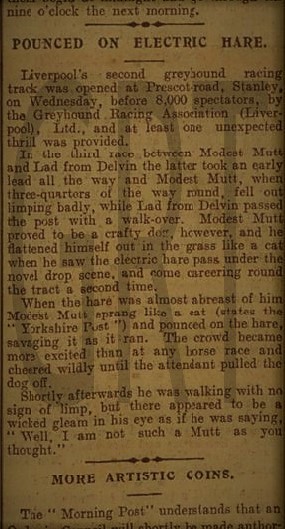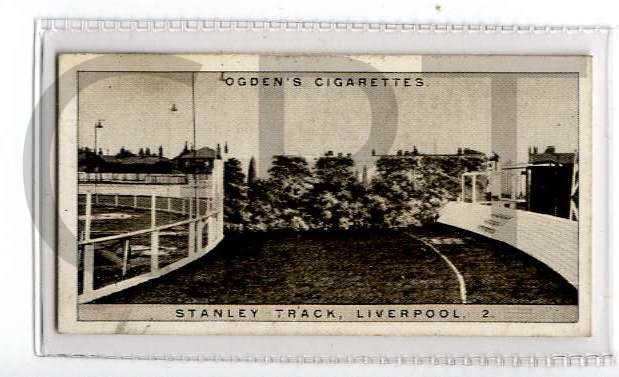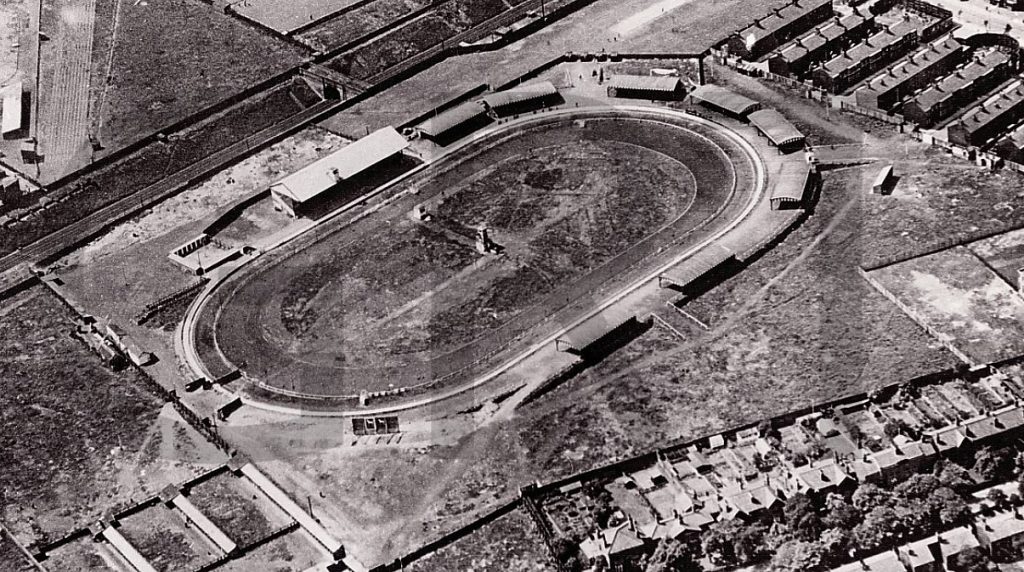Prescot Road, Fairfield, Liverpool, Merseyside.
POSTCODE————————————–L13 2EJ
LOCATED—————————————-Roughly three miles east of Liverpool city centre in the district of Old Swan, just east of a railway line that operates between Prescot Road and Edge Lane.
ORIGINAL SITE———————————Built on the site of an old brickworks and Clay pit next to the Canada Dock railway branch line.
DATE CONSTRUCTED———————–1927
DATE VENUE OPENED———————-August 1927.
Meaning other sports may have taken place prior the arrival of Greyhound Racing.
FIRST MEETING——————————-August 17th 1927.
Greyhound Racing only.
LICENSED OR INDEPENDENT————NGRC
All venues covered would have to be licensed with the government, licensed suggested in this section would refer to tracks operating under NGRC Rules.
INSIDE OR OUTSIDE HARE TYPE——–Outside McKee.
Please note that the Electric Hare suggested is only a guidance and would have been in operation for a certain amount of time at this venue. Although it is not necessarily guarAnteed that it was operational all the time, as other types of lure may have been used and updated as time progressed.
DISTANCES————————————340 and 525 yards.
Please note that most racing venues distances had become varied throughout the years, the ones given above were at once point set and offers only a guidance to the track size.
CIRCUMFERENCE—————————Don’t know.
Please note that alterations at most racing venues throughout its existence would see that the circumference of the track would vary, the one shown above offers only a guidance to the track size.
BIG RACE NAMES—————————None known of.
STADIUM SHARED WITH——————Liverpool Stanley Rugby League Club between 1934 and 1950. Speedway on and off between 1928 and 1960.
LAST MEETING——————————-November 11th 1961.
Greyhound Racing only.
STADIUM CLOSURE DATE—————-November 1961.
Meaning other sports may have taken place after Greyhound Racing had ceased.
STADIUM DEMOLITION——————–The stadium lay idle until 1964 before eventually being demolished. The site lay undeveloped for another five years before a fruit and vedge market was constructed on the site.
BUILT ON SITE——————————— A Wholesale fruit and vedge market which is situated on Church Road.
In some cases, structure’s that originally covered the venue after the stadium had been demolished, may have been themselves demolished too, so the one described is more likely to be the one which now presently covers the site.
EVIDENCE LEFT TODAY——————–None known of.
FURTHER COMMENTS———————During the Second World War the site housed a cluster od Barrage Balloons.

The Local press reports its opening meeting, cutting dated August 19th 1927.







Cigarette collector’s cards from the late 1920’s.



This Silver vase was presented to the winner of a match race between Mallusk & Bridgetown in September 1927 shortly after the track opened. Image provided courtesy of Mr A Nash.

This 1930’s photo shows the venue hosting Rugby League.










These two cuttings printed in The Greyhound Owner dated November 15th 1962.

The city of Liverpool became the home to four Greyhound Racing venues during the boom time of the sport, with The Stanley Greyhound Stadium, described in this chapter becoming its second. This venue was located in the district of Old Swan, an area found three miles east of Liverpool’s city centre, although it lay adjacent to The Canada Dock Railway Branchline, its access was just of Prescot Road.
Stanley Greyhound Stadium would develop from the funds of the Greyhound Racing Association, in response to the disapproval of the newly opened greyhound track at Breck Road track not far away, complaining that the Breck Road management team had copied the GRA’s idea of racing greyhounds behind an electric hare.
It was during summer of 1927 that construction of the stadium began on the flattened site of an old clay pit and brickworks, its main feature being a grandstand that could seat 2,500, which was flanked by other covered standing areas that could accommodate as many as 10,000 patrons in total. It had a large car park, and also a huge kennel block capable of housing 180 greyhounds. With events to be run under rules similar to those of the NGRC, Stanley staged its first meeting on the 17th August 1927, with a very impressive 8,000 patrons in attendance.
The track supplied greyhounds contested over 500 yards, who were no doubt lured by an electric hare that when at the trip, would disappear through a painted wooded area on a canvas sheet, just to send a message to the dogs that the hare was no longer there. In August 1928 Motor Cycle Dirt Track Racing made its first appearance at the venue, and became a popular attraction that would feature almost regularly right up until its final meeting in 1960.
The Stanley Stadium also hosted other sports such as Rugby League, with Liverpool Stanley playing matches there between 1934 and 1950, with Boxing featuring also, along with a variety of musical concerts. During the Second World War all sporting gatherings became cancelled, this due to the Ministry of Defence requisitioning the venue for a barrage balloon site.
In 1960 it was publicly announced that the stadium had been sold to developers, with plans already drawn up to redevelop the site for industrial use. By February 1961 the Speedway promoters announced that no more Speedway meetings would take place, and soon after Greyhound Racing would suffer the same fate, staging its final meeting on the 11th of November 1961.
Although the stadium remained unused and derelict for a few more years following, it was finally demolished in 1965. In 1969 a wholesale fish, fruit and veg market found just off Church Road was built on the site, which still continues to trade today, but sadly this structure leaves no trace of a greyhound track ever being there.
A programme, photograph or even memorabilia for this track is required for this page, if you can help please contact me.

Recent Comments